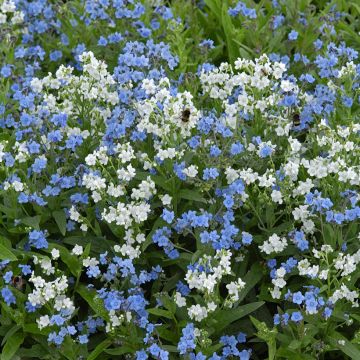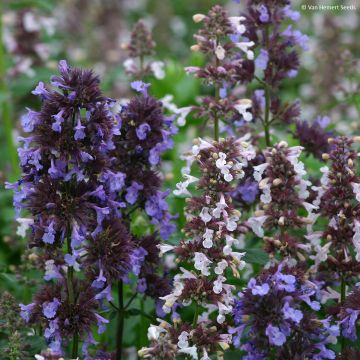

Cynoglossum zeylanicum Mystery Rose - Ceylon hound's tongue seeds


Cynoglossum zeylanicum Mystery Rose - Ceylon hound's tongue seeds
Cynoglossum zeylanicum Mystery Rose - Ceylon hound's tongue seeds
Cynoglossum zeylanicum Mystery Rose
Ceylon hound's tongue
Special offer!
Receive a €20 voucher for any order over €90 (excluding delivery costs, credit notes, and plastic-free options)!
1- Add your favorite plants to your cart.
2- Once you have reached €90, confirm your order (you can even choose the delivery date!).
3- As soon as your order is shipped, you will receive an email containing your voucher code, valid for 3 months (90 days).
Your voucher is unique and can only be used once, for any order with a minimum value of €20, excluding delivery costs.
Can be combined with other current offers, non-divisible and non-refundable.
Home or relay delivery (depending on size and destination)
Schedule delivery date,
and select date in basket
This plant carries a 6 months recovery warranty
More information
We guarantee the quality of our plants for a full growing cycle, and will replace at our expense any plant that fails to recover under normal climatic and planting conditions.
Would this plant suit my garden?
Set up your Plantfit profile →
Description
The 'Mystery Rose' Cynoglossum is a beautiful selection of Chinese Forget-me-not with pastel pink flowers that create a haze of blooms on long stems. It is a hardy annual plant that generously flowers from mid-spring to late summer. The overall effect is ideal for creating colourful movement in flower borders, especially alongside roses and peonies. This variety is also highly sought after in floristry for adding a touch of poetry to bouquets. This plant readily self-seeds over the years where it is happy. Cynoglossum prefers moderately moist and well-drained soil. It can be planted in full sun or partial shade.
The 'Mystery Rose' Cynoglossum is a plant in the borage family, just like common borage and forget-me-nots found in our woodlands. The typical species, known as the Chinese hound's tongue, is native to meadows and mountainous regions in clearings and forest edges in eastern China, as well as India, the Himalayas, and Afghanistan. This biennial plant, usually grown as an annual, forms lanceolate and veined leaf rosettes covered in stiff, slightly dull green hairs, from which hairy stems emerge with leaves that branch out in the upper part. These stems can reach a minimum height of 50cm (20in) and bear inflorescences in terminal racemes from May to August, consisting of small flowers with 5 petals, the colour of which can vary depending on the plants, closely resembling our woodland forget-me-nots. The Chinese forget-me-not self-seeds abundantly in the garden. The 'Mystery Rose' cultivar forms 70cm (28in) tall stems and its foliage covers 30cm (12in) of ground. Its flowers are pale pink with a purplish pink centre. They attract a large number of pollinators.
The 'Mystery Rose' Chinese forget-me-not is as charming as it is robust. It is traditionally used to enhance the beauty of slightly heavy flowers such as double tulips, peonies, and roses by lightening their flowering. It can also be planted in large groups in perennial borders, edging, and containers. It pairs well with many annual flowers such as love-in-a-mist, cosmos, and poppies... The delicate flowers of the Chinese forget-me-not are highly decorative in spring bouquets, alongside irises and lilacs, for example. This simple plant is ideal for brightening up neglected areas of the garden.
Report an error about the product description
Flowering
Foliage
Plant habit
Botanical data
Cynoglossum
zeylanicum
Mystery Rose
Boraginaceae
Ceylon hound's tongue
Cultivar or hybrid
Other Cynoglossum seeds - Hound's tongue
View all →Planting and care
Sow the seeds outdoors, in place, from April to June. Choose a partially shaded location with well-drained, prepared and properly loosened soil. Sow the seeds thinly, barely covering them, in furrows spaced 30 cm (12in) apart. Water regularly, especially during dry periods. Germination usually takes 20 to 25 days. When the plants are large enough to handle, transplant them 15 cm (6in) apart.
Another option is to sow indoors in February-March. Sow on the surface of good quality potting soil at a temperature of 18-23°C (64.4-73.4°F), and cover with a pinch of very fine compost or vermiculite. Keep the seedlings in light, as this aids germination. When the seedlings are large enough to be moved, proceed with transplantation and grow them in a frost-free area until the young plants are large enough to be moved outdoors. You can grow these Chinese forget-me-nots in a frost-free location before planting them in the ground or in pots. They thrive in fertile, well-drained, well loosened soils in full sun or partial shade.
Sowing period
Intended location
This item has not been reviewed yet - be the first to leave a review about it.
Similar products
Haven't found what you were looking for?
Hardiness is the lowest winter temperature a plant can endure without suffering serious damage or even dying. However, hardiness is affected by location (a sheltered area, such as a patio), protection (winter cover) and soil type (hardiness is improved by well-drained soil).

Photo Sharing Terms & Conditions
In order to encourage gardeners to interact and share their experiences, Promesse de fleurs offers various media enabling content to be uploaded onto its Site - in particular via the ‘Photo sharing’ module.
The User agrees to refrain from:
- Posting any content that is illegal, prejudicial, insulting, racist, inciteful to hatred, revisionist, contrary to public decency, that infringes on privacy or on the privacy rights of third parties, in particular the publicity rights of persons and goods, intellectual property rights, or the right to privacy.
- Submitting content on behalf of a third party;
- Impersonate the identity of a third party and/or publish any personal information about a third party;
In general, the User undertakes to refrain from any unethical behaviour.
All Content (in particular text, comments, files, images, photos, videos, creative works, etc.), which may be subject to property or intellectual property rights, image or other private rights, shall remain the property of the User, subject to the limited rights granted by the terms of the licence granted by Promesse de fleurs as stated below. Users are at liberty to publish or not to publish such Content on the Site, notably via the ‘Photo Sharing’ facility, and accept that this Content shall be made public and freely accessible, notably on the Internet.
Users further acknowledge, undertake to have ,and guarantee that they hold all necessary rights and permissions to publish such material on the Site, in particular with regard to the legislation in force pertaining to any privacy, property, intellectual property, image, or contractual rights, or rights of any other nature. By publishing such Content on the Site, Users acknowledge accepting full liability as publishers of the Content within the meaning of the law, and grant Promesse de fleurs, free of charge, an inclusive, worldwide licence for the said Content for the entire duration of its publication, including all reproduction, representation, up/downloading, displaying, performing, transmission, and storage rights.
Users also grant permission for their name to be linked to the Content and accept that this link may not always be made available.
By engaging in posting material, Users consent to their Content becoming automatically accessible on the Internet, in particular on other sites and/or blogs and/or web pages of the Promesse de fleurs site, including in particular social pages and the Promesse de fleurs catalogue.
Users may secure the removal of entrusted content free of charge by issuing a simple request via our contact form.
The flowering period indicated on our website applies to countries and regions located in USDA zone 8 (France, the United Kingdom, Ireland, the Netherlands, etc.)
It will vary according to where you live:
- In zones 9 to 10 (Italy, Spain, Greece, etc.), flowering will occur about 2 to 4 weeks earlier.
- In zones 6 to 7 (Germany, Poland, Slovenia, and lower mountainous regions), flowering will be delayed by 2 to 3 weeks.
- In zone 5 (Central Europe, Scandinavia), blooming will be delayed by 3 to 5 weeks.
In temperate climates, pruning of spring-flowering shrubs (forsythia, spireas, etc.) should be done just after flowering.
Pruning of summer-flowering shrubs (Indian Lilac, Perovskia, etc.) can be done in winter or spring.
In cold regions as well as with frost-sensitive plants, avoid pruning too early when severe frosts may still occur.
The planting period indicated on our website applies to countries and regions located in USDA zone 8 (France, United Kingdom, Ireland, Netherlands).
It will vary according to where you live:
- In Mediterranean zones (Marseille, Madrid, Milan, etc.), autumn and winter are the best planting periods.
- In continental zones (Strasbourg, Munich, Vienna, etc.), delay planting by 2 to 3 weeks in spring and bring it forward by 2 to 4 weeks in autumn.
- In mountainous regions (the Alps, Pyrenees, Carpathians, etc.), it is best to plant in late spring (May-June) or late summer (August-September).
The harvesting period indicated on our website applies to countries and regions in USDA zone 8 (France, England, Ireland, the Netherlands).
In colder areas (Scandinavia, Poland, Austria...) fruit and vegetable harvests are likely to be delayed by 3-4 weeks.
In warmer areas (Italy, Spain, Greece, etc.), harvesting will probably take place earlier, depending on weather conditions.
The sowing periods indicated on our website apply to countries and regions within USDA Zone 8 (France, UK, Ireland, Netherlands).
In colder areas (Scandinavia, Poland, Austria...), delay any outdoor sowing by 3-4 weeks, or sow under glass.
In warmer climes (Italy, Spain, Greece, etc.), bring outdoor sowing forward by a few weeks.











































